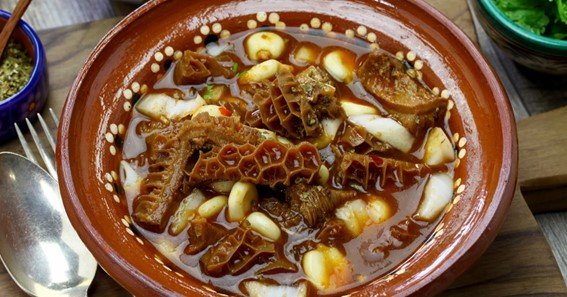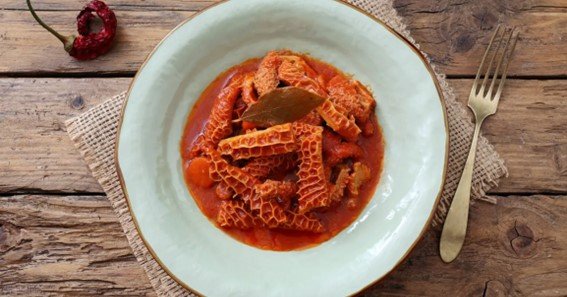What is tripe? Cows, sheep, and goats consume vegetation and have tripe. Its peculiar texture and ability to absorb flavors attract experimental diners and foodies. Though modest, tripe is now a popular element in many cuisines. Learn about this magnificent ingredient’s shapes, preparation, and cultural significance to appreciate and use it more.
What Is Tripe?
Tripe is a type of lining that can be eaten that comes from the guts of different farm animals. Their guts are complex. Each of their four sections breaks down complicated meals. Distinct stomach regions produce distinct tripe. For example, blanket tripe comes from the first section of the stomach, honeycomb tripe from the second, bible tripe from the third, and glandular tripe from the fourth, which is typically not what people desire.
The thick blanket tripe, honeycomb tripe with diamond patterns, and folded bible tripe all feel different. Farm-to-table tripe requires cleaning, dressing, cooking, and serving. Understanding these methods and tripe’s cultural traditions might help you prepare and appreciate this unusual vegetable.
Read on to learn more about what is tripe.
Different Tripe Types

Tripe kinds vary by stomach location. The blanket tripe begins here. Recipes that require a firm structure employ its solid, fuzzy texture. Second-section tripe is highly sought after. The soft, honeycomb-like surface is ideal for soups and stews that emphasize texture. The third segment, biblical tripe, has a distinctive texture that fits well with heavy dishes due to its folded layers, which resemble book pages. Fourth compartment tripe is less frequent in cooking due to its glandular texture, yet several classic dishes include it.
Using the proper tripe for a dish can improve the results. Knowing the differences between tripe types helps chefs choose how to use them in recipes.
Trip Prep
Dressing thoroughly cleans the tripe before cooking. Boiling the stomach removes the lining. Cleansing the stomach removes fat and dirt. Most butchers bleach tripe to make it seem prettier and attract clients. This crucial initial step cleans and prepares tripe for cooking.
Dressing tripe is complex and requires careful attention to remove any unnecessary pieces. This may anger some, but others consider it a work of love and essential to preparing a wonderful, healthy dinner.
Cooking Tripe
Long-simmering tripe softens. Remove bleach and other contaminants from fresh tripe by rinsing and boiling. You can cook tripe for 10 hours, depending on the method. If you prepare tripe properly, it will be soft and absorb the tastes of your cuisine.
A Tripe Taste Profile
It may be strange to eat intestinal lining, but well-cooked tripe tastes good. Like tofu, it’s versatile and can take on different tastes. It pairs well with fragrant flowers, onions, and garlic.
Tripe pairs nicely with various spices and vegetables because of its mild taste. Tripe will absorb the flavors of other foods when simmered in a hot broth, stewed with vegetables, or grilled with herbs, creating a delicious dinner.
Global Tripe Dishes
Traditional dishes worldwide use tripe. UK residents cook tripe and onions in milk, demonstrating its simplicity and comfort. Italians boil tripe alla Fiorentina in tomato sauce, making it rich and satisfying. Belgium’s tripe and France’s Andouille sausage employ tripe differently across Europe. Traditional and flavorful Latin American soups and stews like mondongo and cau use it. Asian and African cuisines prepare trips differently, with different tastes and methods.
Traditional dishes across the world use tripe, demonstrating its cultural importance. These recipes explain the history and custom of each meal and the unique flavors and textures of tripe.
Amazing Facts About Tripe

Low in fat and high in protein, tripe is healthy. B12, zinc, and iron are vital vitamins and minerals. These nutrients make it a healthy complement to a diet.
Tripe is substantial in protein and low in calories and fat, making it a smart choice for a balanced diet. Due to its vitamin and mineral content, it’s a good alternative for those seeking extra nutrition.
Famous Tripe Recipes
Famous tripe dishes include menudo from Mexico, guitars from Ecuador, and trippa alla romana from Italy. These recipes demonstrate how tripe may enhance many foods. Looking at these recipes might inspire you and introduce new cuisines.
Mexican menudo is full and delicious and made with hominy and honeycomb tripe. Try guatitas, an Ecuadorian tripe and potato stew, to demonstrate its versatility. Italy traditionally cooks tripe in tomato sauce, called trippa alla romana. This dish highlights the tripe’s deep, savory taste.
Modern Food Tripe
Chefs are adapting historic tripe recipes for contemporary meals. Tripe’s texture and taste absorption make it popular in gourmet restaurants and food festivals. This revival suggests that “nose-to-tail” cooking is gaining popularity.
Tripe is gaining popularity again as cooks and foodies prepare from head to tail. Its texture and taste absorption make it a popular component for innovative cuisines. People praise tripe for its varied cooking purposes, from food fairs to high-end restaurants.
Conclusion
Tripe is a popular ingredient in many dishes worldwide despite its unusual origins. Its unique texture and capacity to absorb tastes make it handy in many recipes. Anyone wanting to experiment can prepare tripe in stews, soups, or fries. Traditional vegetables are becoming increasingly popular in cooking worldwide, making tripe fashionable again. If you know how to prepare tripe and what it represents to different cultures, you may appreciate its rich history and numerous delectable possibilities.
FAQ
What Tripe Types Exist?
Ruminants’ guts have four sections. Blanket, honeycomb, bible, and less common fourth compartment tripe originate from the first, second, third, and fourth compartments, respectively.
How Do You Prepare And Clean The Tripe?
The dressing is thorough tripe cleansing. Boiling the stomach removes the lining, cleaning it removes grit and fat, and bleaching improves its appearance.
How To Prepare A Tripe?
Long-simmering tripe softens. I am simmering time depending on the recipe. Rinsing and blanching fresh tripe before cooking is essential.
What Tripe Dishes Are Famous?
Menudo from Mexico, trippa alla Fiorentina from Italy, guitars from Ecuador, and tripe and onions from the UK are famous tripe dishes. These dishes demonstrate tripe’s prominence in global cuisine.
Can Vegan People Have Tripe?
Big No
Similar topics: What Is Sausage Made Of?
Sources:
https://www.foodrepublic.com/1287984/what-is-tripe-when-edible
https://www.thespruceeats.com/information-about-tripe-2342853
https://www.healthline.com/nutrition/tripe
We have covered all the below topics in the above article
Tripe definition
Meaning of tripe
Tripe explanation
What does tripe mean










